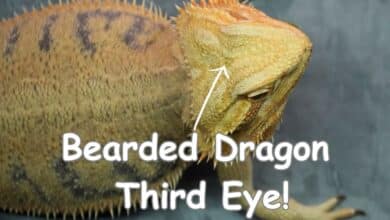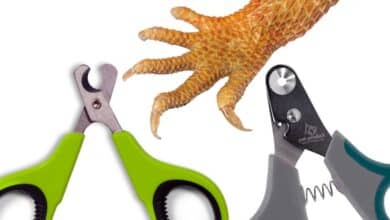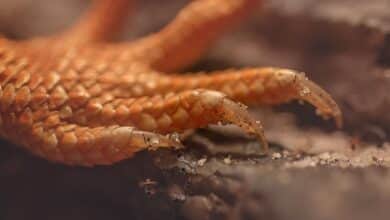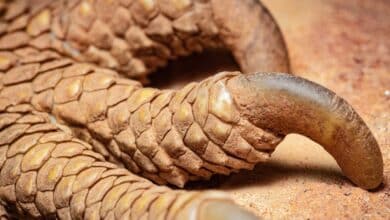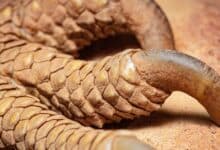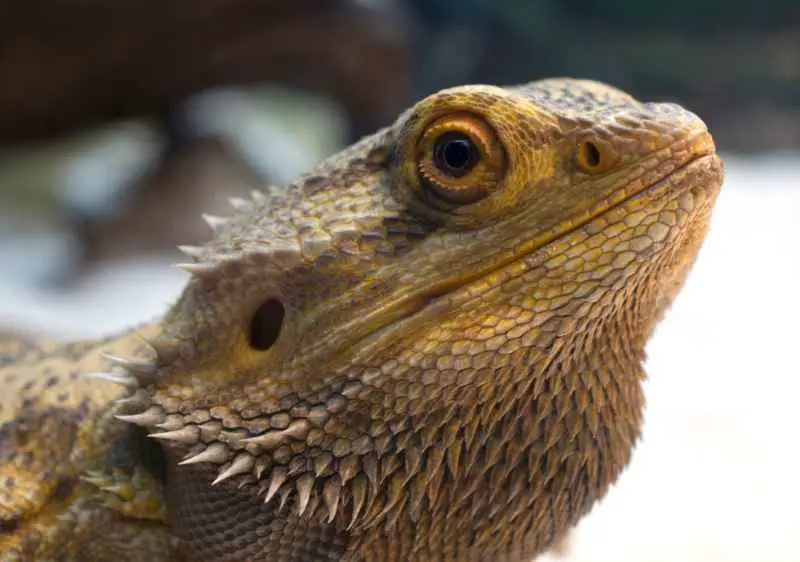All About Bearded Dragon Eye Issues and What To Do About Them
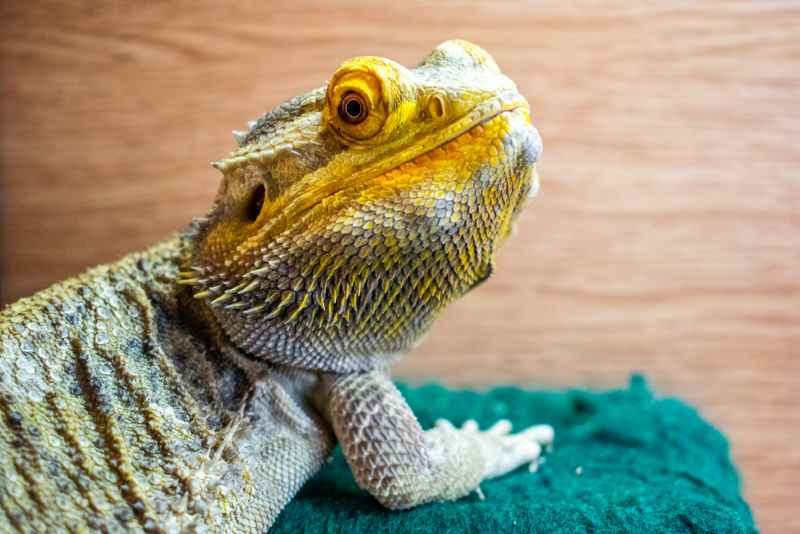
It’s not unusual for a bearded dragon to experience eye problems. It’s really rather frequent in reptiles. After all, reptiles have eyelids that are similar to ours, with the exception that the lower lid moves more.
Bearded dragons, like humans, can suffer a variety of eye problems. Eye discoloration, enlarged eyes, sunken eyes, drooping eyes, wet eyes, and other abnormalities can unfortunately occur. Knowing the probable causes of these eye disorders will help you identify and treat your bearded dragon as soon as possible to prevent permanent damage to your lizard’s health.
Continue reading to learn more about bearded dragon eye difficulties, what to do about them, and how to avoid future eye problems like discoloration or problems that can cause pain such as swelling, bulging, drooping, and watery eyes from arising in the future.
Contents
Red or Purple Eyes

What Does It Mean If a Bearded Dragon Has Red or Purple Eyes?
If your bearded dragon’s eyes appear red or purple in color, this is usually a sign of discomfort or illness. However, it can also be a sign of a more serious injury.
If you notice any discoloration in your bearded dragon’s eye, you should then observe them closely in order to determine whether this discoloration is caused by an eye infection. Eye discharge, drooping eyes, crusty eyes, black or red specks around the eye, and enlarged eyes are all signs of an eye infection in a bearded dragon.
Another explanation for your bearded dragon’s red eyes could be shedding. After all, the shedding process can be aggravating for your beardie, especially if the humidity in their tank isn’t high enough.
What To Do If a Bearded Dragon Has Red or Purple Eyes?
If your bearded dragon’s eyes get red or purple, this should not be ignored because it is one of the earliest signs of an eye infection. As a result, if you see any of the symptoms of an infection in your pet’s eyes, take them to the veterinarian immediately because untreated eye infections can cause severe eye damage.
Owners can also clear up any discharge or crust in or around their bearded dragon’s eye by bathing their bearded dragon in warm water. However, make sure you do this softly, so you don’t aggravate their eye condition any further.
Puffy/Swollen Eyes

What Does It Mean If a Bearded Dragon Has Puffy or Swollen Eyes?
Eye edema is frequent among bearded dragon owners, and it can be caused by a variety of conditions ranging from infections to discomfort. Swollen or puffy eyes of a bearded dragon, for example, can signal that he or she is shedding, has an excess of vitamin A, parasites, or even an eye infection.
A tumor, clogged tear ducts, and compromised blood vessels can also all cause swollen eyes in bearded dragons.
What To Do If Your Bearded Dragon Has Puffy or Swollen Eyes?
A bearded dragon’s skin will fade and turn grey before they shed, and their eyes will get somewhat enlarged. This is completely normal and indicates a healthy shed cycle.
However, if your bearded dragon’s eyes appear puffy or swollen for any other reason, it is best to get veterinary assistance as soon as possible to avoid infection and obtain the right treatment. Your veterinarian will then most likely do an X-ray, blood test, and culture swab to discover the cause.
Bulging Eyes

What Does It Mean If a Bearded Dragon’s Eye Is Bulging?
A bearded dragon’s eyes occasionally bulge out of their sockets, pushing out the lids and skin around the eyes. This usually only lasts a fraction of a second before the eyes revert to their original form; in some cases, it happens so rapidly that owners are unaware of the behavior.
Don’t be surprised if your bearded dragon’s eyes protrude out. This is a regular behavior among bearded dragons; however, no one knows why they do it.
However, while eye-bulging is a common occurrence, it can sometimes be concerning. If your bearded dragon exhibits this behavior for more than an hour at a time, you should consult a veterinarian to ensure that your beardie’s blood pressure is normal.
What To Do If a Bearded Dragon’s Eye is Bulging?
A bearded dragon with protruding eyes is generally nothing to be concerned about. It appears to be a natural approach for your beardie to assist itself when shedding. However, when your bearded dragon is in this stage, it’s always a good idea to keep an eye on it to see how often and how long it happens.
For example, if you observe your bearded dragon’s eye bulging for an extended period of time, you should take them to the veterinarian for a check-up.
While most cases of eye bulging are considered innocuous, if the behavior persists for an extended length of time, this can be an early indicator that your bearded dragon is suffering from a more serious health condition like high blood pressure.
Closed Eyes

What Does It Mean If Your Bearded Dragon’s Eyes Stay Closed?
There could be a number of reasons why your bearded dragon’s eye or eyes won’t open. For example, if your bearded dragon is squinting, the cause could be temporary or a symptom of a developing sickness.
Damage to the eye, dehydration, illness, an unintentional injury, scrape, or a shedding issue are all also possible reasons for a bearded dragon’s eye to be closed. If your bearded dragon doesn’t open its eyes, and also appears sluggish, listless, or refuses to eat or drink, this could also be an indication that your bearded dragon could also be extremely unwell.
What To Do If You Notice Your Bearded Dragon’s Eye Stays Closed?
Dehydration, corneal injury, harsh lighting, sickness, and vitamin shortage are the most common reasons why a bearded dragon won’t open its eyes. Fortunately, with a decent diet, a well-maintained habitat, and frequent vet visits, these conditions are easily cured and prevented.
However, some illnesses, such as infection and injuries, are too difficult to handle on your own. As a result, if you think the condition of your bearded dragon’s eye is serious, take your reptile to the vet. After all, some infections can damage the retina and cause blindness. Antibiotics or reptile eye drops can also be prescribed by the veterinarian to treat the infections.
Eyes Appear Sunken

What Does It Mean If Your Bearded Dragon’s Eye Appears Sunken?
If your bearded dragon’s eyes appear sunken, they may be suffering from dehydration. While bearded dragons do not require a lot of water, they can and will still suffer from dehydration. After all, these lizards acquire most of their water from their diet. As a result, if you encourage your bearded dragon to consume a lot of greens, dehydration should not be an issue.
However, one typical issue is that individuals give their bearded dragons water in their feeding bowls. Bearded dragons in the wild only drink moving water, thus owners must either provide a flowing water source or supplement their beardies’ hydration with nutrients from their food.
What To Do If You Notice That Your Bearded Dragon’s Eye Appears Sunken?
Bearded dragons with sunken eyes indicate that something is amiss with their health. You should, therefore, get the reptile looked at as quickly as possible to figure out what’s wrong with them and avoid allowing the situation to get worse.
A bearded dragon’s eyes will seem sunken with whites and poor skin pigmentation surrounding them in most situations of dehydration, which is one of the major causes of this illness. Give fluids as soon as dehydration sets in by dropping food soaked in water into their mouths or using an eyedropper to place a few drops on their tongue.
It is also, however, important to note that severe dehydration should be addressed immediately since excessive dehydration in lizards can cause major discomfort and even death if not treated or rectified quickly enough.
Drooping Eyes

What Can It Mean If Your Bearded Dragon’s Eye Begins Drooping?
Although some bearded dragons have naturally drooping eyes, this form of eye disease is usually caused by a variety of factors. When a beardie’s eyelids droop to the point of looking like a bloodhound, they may be suffering from an illness, dehydration, or parasites.
It is also, however, likely that your lizard is suffering from renal problems. Swollen or puffy eyes can also be a sign of this serious health problem.
What To Do If Your Notice Your Bearded Dragon’s Eye Start to Droop?
Bearded dragon eye drooping isn’t a life-threatening condition, so don’t be concerned. After all, if the problem is handled quickly, it is quite possible to preserve your pet’s life and prevent serious health consequences such as blindness.
However, if your bearded dragon’s eyes are drooping but it isn’t dehydrated, this could be a sign of renal disease, vitamin A deficiency, eye infection, or parasites. Therefore, when your pet has this ailment, it is usually best to seek the advice of your local reptile veterinarian.
Watery Eyes
What Does It Mean If Your Bearded Dragon’s Eyes Begin Watering?
A foreign item in the eye, similar to what you would experience if a speck of sand or piece of dirt went into your eye, is the most prevalent cause of eye-watering in bearded dragons. Additionally, minor conjunctivitis and inflammation in the front layer of the eye caused by bacteria or viruses can cause your bearded dragon’s eyes to water.
What To Do If Your Bearded Dragon’s Eyes Start to Water?
To assist eliminate whatever is causing the discomfort to your beardie’s eye, owners can try cleaning their bearded dragon’s eye with water. When it comes to eliminating foreign particles from the eye, a simple saline solution can also be quite beneficial.
If this does not help, your veterinarian should be able to prescribe you antibacterial eye drops that will also assist to clean up any conjunctivitis and, as a result, stop your dragon’s eyes from watering.
Eye Infections
What Is a Bearded Dragon Eye Infection?
There are a variety of reasons why your bearded dragon’s eye may become infected. Identifying the source of the illness can assist to reduce the risk of infection in the future.
A vitamin A deficiency, for example, is the most prevalent cause of an eye infection in a bearded dragon. They are omnivorous, meaning they consume insects and leafy greens, and they frequently suffer from vitamin deficiencies, which can lead to eye infections.
In your bearded dragon, ocular discharge is also an indication of infection. Any discharge from the eye should be treated by a veterinarian as soon as possible.
What To Do If You Think Your Bearded Dragon Has an Eye Infection?
The vet will be able to inspect your bearded dragon’s eye and determine whether there is any damage, as well as diagnose the kind of infection by performing bacterial and viral culture checks. They will then prescribe antibiotics for you to use in treating your bearded dragon, as well as a treatment plan to assist you to nurse your bearded dragon back to health.
Mites
What Are Mites?
Swelling and weeping of your bearded dragon’s eye or eyes can be caused by parasites. Mites frequently find the region around the eye to be hospitable, causing a slew of issues for your bearded dragon, including shedding issues and more.
Ticks can also be present if you recently brought your bearded dragon home. After all, ticks are quite frequent in wild-caught reptiles, as well as those that have come into direct or indirect touch with one.
What To Do If You Think Your Bearded Dragon Has Mites?
Bearded dragon mites are carriers of dangerous viruses and bacteria that can hurt bearded dragons severely. The best course of action is to take preventative measures to ensure that your beardie never gets them in the first place. Unfortunately, once mites have entered your bearded dragon’s habitat, they’re difficult to eradicate.
Mites, after all, are nocturnal, reproduce swiftly, and spread quickly. As a result, by the time you find them in your bearded dragon’s enclosure, they have most likely contaminated the entire tank.
It’s also important to remember that the chemicals used to kill mites will also harm your reptile. As a result, while you must also use poisonous chemicals to treat the enclosure and its contents, make sure you only use non-toxic remedies to treat your lizard. Consult your local veterinarian if you are not sure how to do this safely.
How To Prevent Your Bearded Dragon from Developing Eye Problems in The Future?
At the end of the day, preventing eye illnesses is always preferable to putting your bearded dragon through the discomfort of any eye troubles that could arise throughout their lifetime. A preventive approach can, therefore, help your dragon stay happy and healthy by minimizing a variety of eye problems.
To help your bearded dragon prevent eye issues, owners should provide them clean habitat. This should include regular inspections and monthly cleans. To limit the danger of mites and parasites, ensure sure the substrate is kept clean.
Owners should also keep an eye on the temperature and humidity of their beardie’s tank to ensure that they are kept in the best possible circumstances. A sufficient amount of light is also necessary to keep your bearded dragon healthy and powerful.
Final Thoughts
Like humans, bearded dragons can develop a range of eye disorders. Unfortunately, eye discoloration, swelling, sunken eyes, drooping eyes, and watery eyes, among other eye abnormalities can all occur. Knowing the most likely causes of these eye problems can assist you in identifying and treating your bearded dragon as soon as possible to avoid irreparable harm to their health.
However, avoiding eye diseases is always preferable to putting your bearded dragon through the discomfort of any eye problems that may emerge over their lifespan. By reducing a range of eye disorders, a preventative approach can help your dragon stay happy and healthy.
